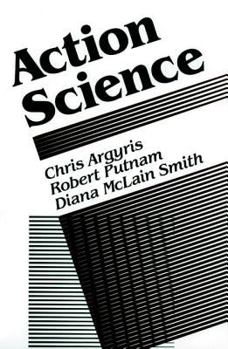Action Science: Concepts, Methods, and Skills for Research and Intervention
A great read for any enthusiast! This description may be from another edition of this product.
Format:Hardcover
Language:English
ISBN:0875896650
ISBN13:9780875896656
Release Date:November 1985
Publisher:Jossey-Bass
Length:480 Pages
Weight:1.95 lbs.
Customer Reviews
2 ratings
Available for Free Download
Published by Thriftbooks.com User , 15 years ago
From the Action Design Website: The book Action Science: Concepts, Methods, and Skills for Research and Intervention, by Chris Argyris, Robert Putnam, and Diana McLain Smith, was published by Jossey-Bass in 1985 and remained in print until 2000. It has become a standard text in several graduate-level courses. In the interests of continuing to make it available to scholars, researchers, and practitioners, we are providing the full text, chapter by chapter, in PDF format. Go to [...]
Definitely tough...and more than definitely worth the time.
Published by Thriftbooks.com User , 22 years ago
Action Science (1985) is the result of a collaborative project by Chris Argyris, Robert Putnam and Diana McLain Smith. The authors' main objective was to produce a body of knowledge that would bridge the concepts between theory and practice, thought and action and science and common sense (Argyris, Putnam, and McLain Smith, p.1). The authors' collective experience and expertise establishes them as credible, competent and well versed in the field of leadership. I am convinced that as a group of professionals they are uniquely qualified to comment on the concepts, methods, and skills for research and intervention.Embedded in the text of this work is a tremendous amount of information that is documented and supported by research and established theories. I believe the authors did achieve what they set out to do and ended with a useable, comprehensive, and valid body of knowledge. The information presented in the tables and figures offers clarity and visual reference for data that may otherwise be confusing and frustrating. Argyris and Schon in Educating the Reflective Practioner (1974) state, "All human beings - not only professional practitioners - need to become competent in taking action and simultaneously reflecting on this action to learn from it." In the process of doing this review, I became engaged in an exercise of self-reflection. I began the task of defining my professional behavior and can sum up my experience by asking what is it that I am doing, why I am doing it, how am I doing it and what I could do different to grow and learn. Finally, I would like to highlight passages that caused me to reflect on my professional practice and development. 1. The concept of double loop learning makes sense and is something I am going to attempt to increase my awareness level.2. The explanation of espoused theory versus theory-in use conveys a level of unawareness (on the part of most professionals) concerning what they do in contrast to what they think or say they do. 3. Barriers that inhibit our learning are self erected coping mechanisms that may serve a purpose but they are not strategies that will help us grow or learn professionally.One assertion explored in the text is that by identifying the barriers that exist in our communities of inquiry we might be more prepared to overcome these barriers (Argyris et al. p.89). By defining our barriers we become better equipped to overcome these barriers. In reading Action Science I engaged in a professional exercise of reflective thought. On every page there is material, concepts and theories that are worthy of reflection. I found myself engaged in reflective thought and self-discovery throughout the reading of this text.





